Nigerian banks have been described as “sleeping giants”, following the lower than expected banking penetration in the country, compared with the country’s demography which presents a massive opportunity for the sector to expand.
Global consulting firm, Mckinsey, stated this in its 2018 report titled: “Roaring to Life: Growth and Innovation in African Retail Banking,” obtained at the weekend.
The 54-page report also described Nigeria’s oil-producing peer, Angola as a “sleeping giant, noting that at the respective income levels of their financial institutions, banking penetration in both countries ought to be higher.
According to Mckinsey, the prominence of oil in a national economy often steers banks away from lending more to other sectors, or to the consumer market.
“In these markets, we also see credit bureau coverage of only three per cent—the lowest of the four archetypes—and less innovation in areas such as mobile money,” it added.
The report identified four archetypes in African banking markets—each with markedly different per capita income, banking penetration, revenue growth, profitability, and financial infrastructure – to include the mature market, which includes countries such as Egypt and South Africa, with higher GDP per capita and asset penetration; the fast-growing transition market, which covers countries like Ghana, Cote d’Ivoire, and Kenya, where banking penetration is ahead of the curve; the sleeping giants, which Nigeria is part of; and the nascent market, which includes countries such as Ethiopia and Tanzania.
Mckinsey pointed out that globally, the banking industry was facing disappointing returns and sluggish growth, adding that for seven consecutive years, its return on equity (ROE) has been stuck in a narrowly defined range of between eight percent and 10 per cent—a level most consider the industry’s cost of equity.
But it stressed that banks in Nigeria and other African countries provide a refreshing contrast as their markets were fast-growing and nearly twice as profitable as the global average.
“Although competition is heightening and regulation is tightening, there is still much room to grow: Africa’s retail banking penetration stands at just 38 per cent of GDP, half the global average for emerging markets.
“Africa’s banks face challenges aplenty, including low-income levels in many countries, widespread use of cash in most economies, and poor coverage of credit bureaus.
“But some banks are already tapping the opportunities inherent in these challenges, for example harnessing Africa’s widespread mobile-phone coverage to create low-price offerings and innovative distribution models.
“Driven by such innovation, African retail banking’s revenue growth could accelerate significantly in the next five years.
“Africa’s fast-growing, profitable banking markets, global media reports, are more likely to highlight Africa’s social and political problems than its rise as a business market.
“Yet the reality is that the continent is in the midst of an historic acceleration that is lifting millions out of poverty, creating an emerging consumer class, and propelling rapid economic growth in many economies,” Mckinsey stated.
It revealed that Africa’s banking sector is the second-fastest-growing market in the world, taking both retail and wholesale banking together.
Between 2012 and 2017, African banking revenue pools grew at a compound annual growth rate of 11 per cent in constant 2017 exchange rates, just as it anticipated that the African banking market would remain a growth leader going forward, growing at a rate of 8.5 per cent in the next five years.
“In terms of size, Africa’s banking market is today approximately $86 billion in revenues before risk cost. Our projected growth for African banking revenue pools of 8.5 per cent a year between 2017 and 2022 will bring the continent’s total banking revenues to $129 billion.
“Of that total, $53 billion will be in retail banking—up from $35 billion in 2017—an absolute growth in retail banking revenues of $18 billion.
“Africa is a continent of 54 countries, leading to some inevitable fragmentation of the banking opportunity. We estimate that the top five banking markets in Africa—South Africa, Nigeria, Egypt, Angola, and Morocco—account for 68 per cent of the total banking revenue pool, compared to over 90 per cent for the top five regions such as North America, Latin America, Middle East, and Emerging Asia.
“For Africa, this means that the remaining 49 countries represent only 32 percent of the revenue pool. Furthermore, Africa’s banking markets exhibit high variation in growth and profitability.
“It thus becomes extremely important for banks to draw the right map—the first of the winning practices, we believe will be crucial to success in the coming years,” the consulting firm stated.
While stressing the importance of banks having the right winning strategy for retail banking, it cited the example of Guaranty Trust Bank (GTBank) Plc.
According to the report, GTBank’s average ROE of 30 per cent between 2011 and 2016 out-performed Nigeria’s other top five banks, which posted ROEs of 11 to 22 percent.
“GTBank has had great success in Nigeria’s affluent segment, based on high service levels. It has been rated best in class in terms of CSAT, a measure of client experience.
“Focusing on the higher-income segments has also enabled GTBank to keep their branch network smaller relative to those of their competitors,” it added.














